Looking for a unique and intriguing fungi to add to your knowledge base and culinary adventures? Consider the lobster mushroom, a bright orange to red fungus that is reasonably plentiful but hard to predict due to its unique nature not as a mushroom but as a parasite.
They’re delicious, unique, and intriguing. Let’s go take a look.
Classification
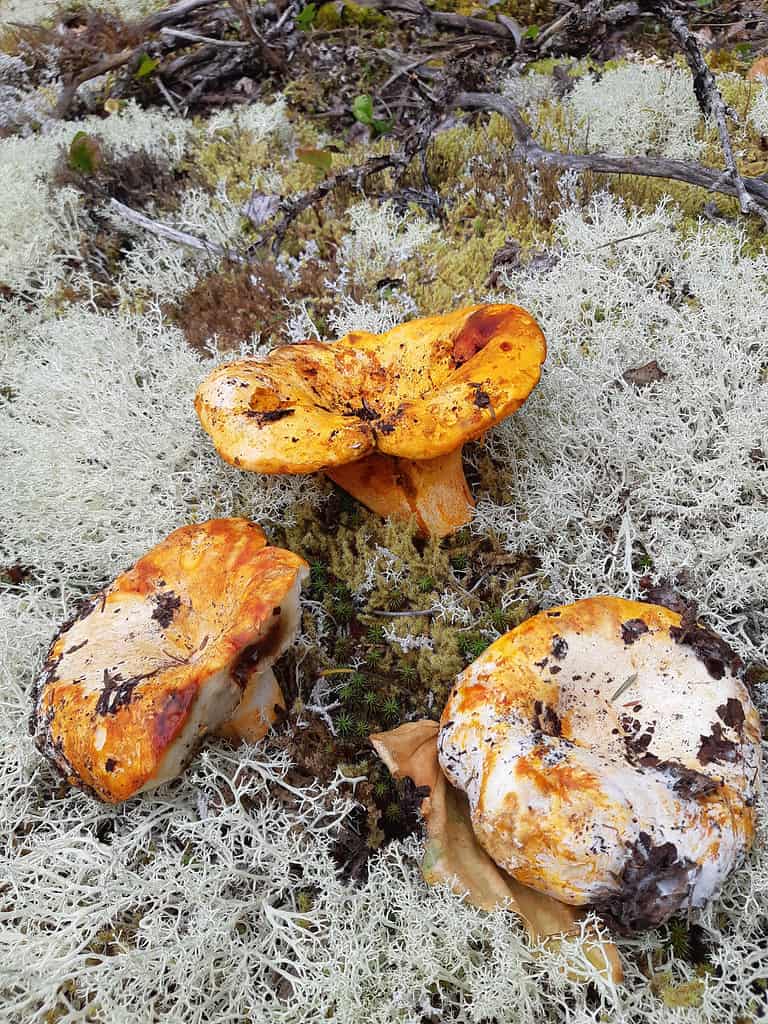
Lobster mushrooms grow among lichen and moss.
©Kal Galloway/Shutterstock.com
While we call them mushrooms, lobster mushrooms are not mushrooms at all, but rather parasitic fungi that latches onto other fungi (mushrooms) and takes them over. The scientific name is Hypomyces lactifluorum. They envelope mushrooms and change their appearance, which is why there are some uniquely shaped lobster mushrooms to find. The reason the fungi are called lobster mushrooms is due to the color change of the lobster mushroom to a red like a lobster when it is cooked. They belong to the Hypocreaceae family.
Where Do Lobster Mushrooms Grow?

The color is often extremely vivid.
©Gunsmith Photos/Shutterstock.com
These unique fungi can be found between July and October, usually, all over the woodlands and forests of the United States. They often grow in clusters but may appear as singular fungus or pairs, and usually near hemlock trees. They also thrive throughout British Columbia and many other regions in the north. They are often found at other conifers as well, largely because these are the trees their favorite hosts love: Russulla brevipes. They are also one of the few edible mushrooms that can grow well under cedar trees. They usually do not grow at low or particularly high altitudes, either, and spring up after heavy rains.
Are Lobster Mushrooms Safe to Eat?
Lobster mushrooms are one of the favored culinary mushrooms available in the United States.
What Do Lobster Mushrooms Taste Like?
Lobster mushrooms have variable flavor, depending on the host species of fungi they grab onto. Generally speaking, though, they have a meaty texture, with a sweet, nutty aroma reminiscent of freshly cooked lobster. This fungi growing on the host mushrooms is what gives them their distinctive flavor, by the way, as they generally choose bland hosts.
How Are Lobster Mushrooms Used?
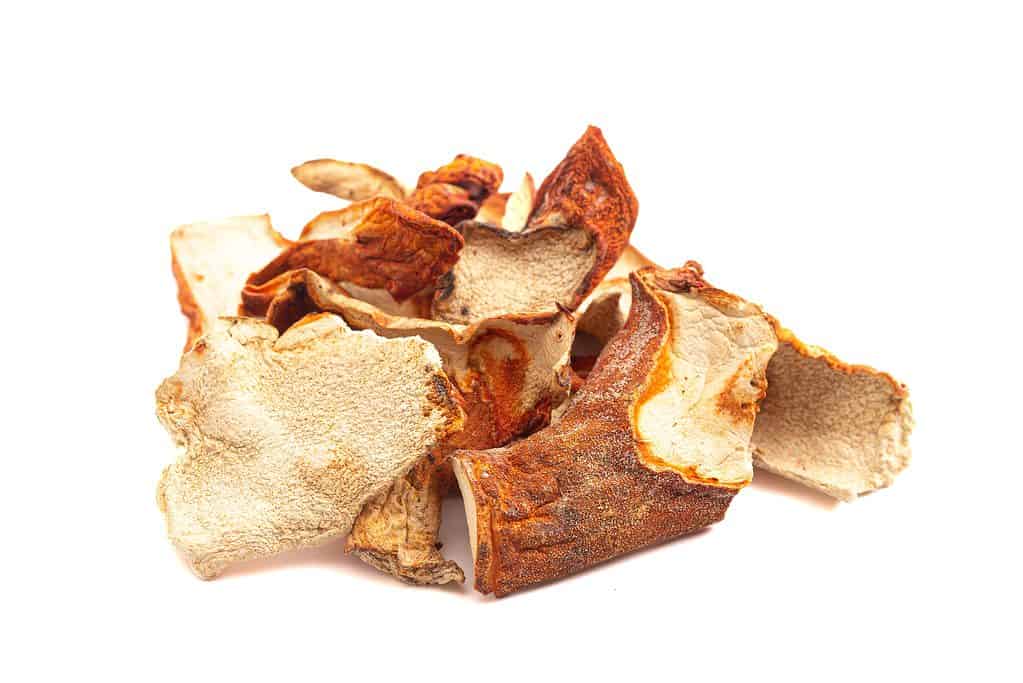
They are often dried and reconstituted.
©P Maxwell Photography/Shutterstock.com
Fresh lobster mushrooms have completely white interior flesh and are the best tasting of the options, though dried and reconstituted may be used as well. The dried mushrooms may also be ground into a powder and added to dishes as a sort of seasoning.
Sauteing and pan-frying are probably the most popular methods for cooking lobster mushrooms. They do best in moist cooking methods, as this keeps them tender and applies their flavor best. As the mushrooms cook, you will notice the orange or red coloring leaches out into the rest of the food, as well.
Lobster mushrooms are often chopped and fried into tempura and are added to seafood dishes with lobster and crab and are a favorite addition to bisques. They enhance the seafood flavor and vice versa.
The mushrooms mush be carefully cleaned before use, though, as they often contain a fair bit of dirt in the concave caps and between the cracks. Use a dry brush to wipe away the dirt and avoid the typical damp cloth as those may wipe away that distinctive coloring which gives them such unique flavoring. Break the mushroom apart, as needed, to properly clean, and cut off any brown spots on the surface.
Health Benefits

Man’s hand holding lobster mushroom
©Raphael Rivest/Shutterstock.com
Lobster mushrooms contain many nutrients, partially from their host fungi and partially from their own contents. The host fungus varies, but most mushroom species offer copper, iron, manganese, magnesium, potassium, phosphorous, zinc, and selenium. Additionally, lobster mushrooms have Vitamin D and Vitamin B.
While you should never ditch medications in favor of dietary consumption without consulting a medical care provider, mushrooms in general are known to help boost the diet and therefore health of an individual. Lobster mushrooms are particularly believed to aid the body in regulation of important minerals (i.e., help the body absorb nutrients better), boosting immune system health, alleviate some symptoms of depression, reduce inflammation, reduce risk for certain aging diseases, reduce risk for pneumonia, boost heart health, lower cholesterol, reduce constipation symptoms, improve red blood cell production, and generally improve overall health.
There have been studies that show the various nutrients found therein help each of these conditions. However, consuming lobster mushrooms will only help a little bit in these areas and are not a cure-all.
How Much Do Lobster Mushrooms Cost?
Because lobster mushrooms are rarely cultivated for commercial harvest, they tend to be on the pricier side. You’ll find them in specialty markets and possibly farmer’s markets, often at around $22 to $30 per pound.
How to Identify Lobster Mushrooms
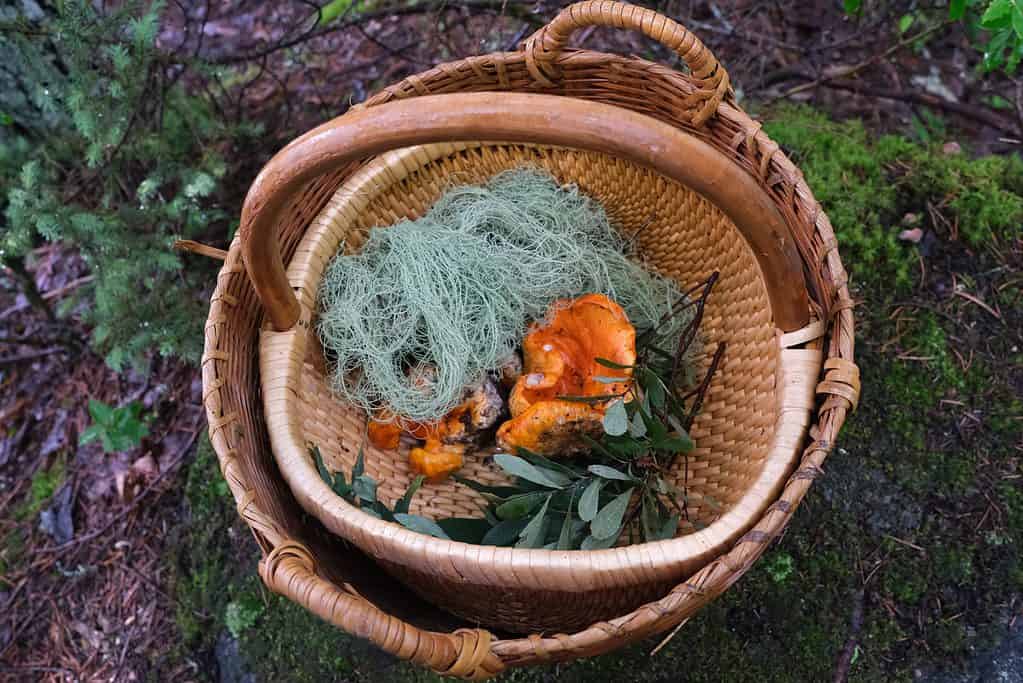
Be sure to bring proper supplies, including a basket for collecting your mushrooms.
©Mathew Shawn Turner/Shutterstock.com
Thanks to their unique characteristics, lobster mushrooms are usually fairly easy to identify, even for beginner foragers. Here’s what to look for.
- They are always bright orange to orange-red coloration
- They do not have gills
- They bare a hard, rough exterior
- Typically, they are vase-shaped or folded
- They usually have dirty, cracked tops
- The caps are twisted, folded, or oddly shaped
- The interior is white to orange-white, hard, and dense
- Older specimens may be wine-purple or pink with younger specimens nearby (skip the old ones!)
How to Forage for Lobster Mushrooms
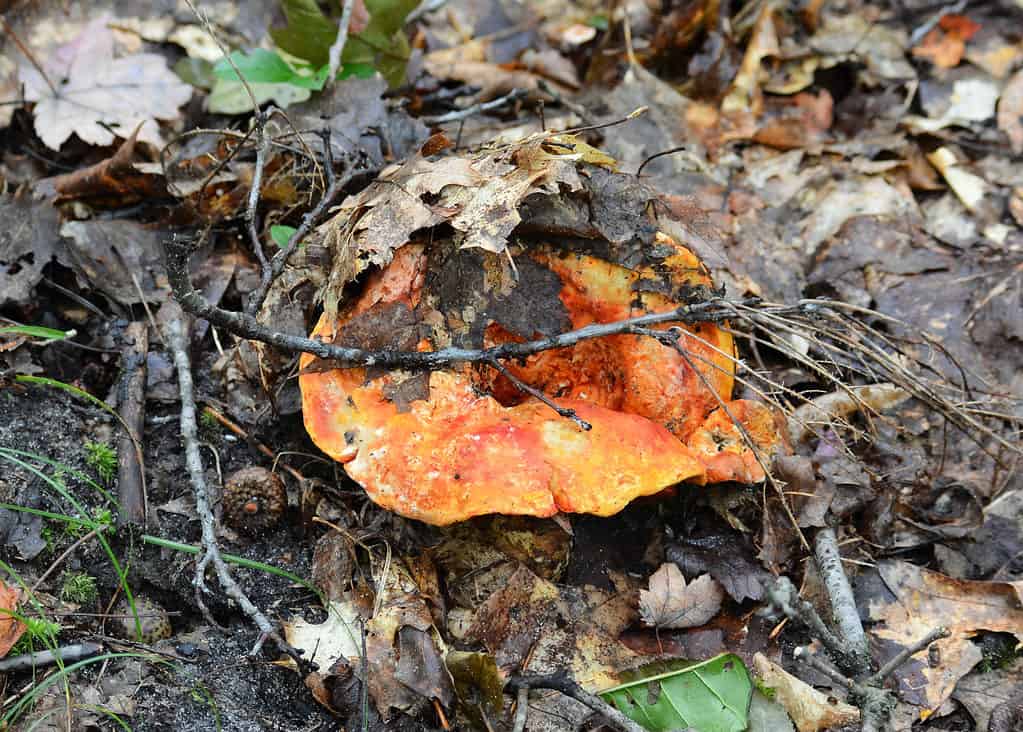
Look carefully – they often hide among forest debris!
©akslocum/Shutterstock.com
Foraging for lobster mushrooms is actually a great choice for beginners, as they are one of the easiest species to identify, thanks to their unique looks. You’ll make the find the best month for foraging in your area as your first step, and then follow these other suggestions. Note that most lobster mushrooms are prime for the harvesting in late autumn, wherever you are in the world and generally don’t follow a set season otherwise, since they grow on the other fungi. They may be found any time except winter.
Take Copious Notes
Because lobster mushrooms are extremely hard to predict (season-wise), it’s important to take copious notes as you go out foraging. Look for those bright orange caps and note the location, date found, and weather conditions. This will help you forage again in the future. Look for them in any season except autumn and track their growth times to determine your best options for proceeding years.
Look After Heavy Rainfall
Lobster mushrooms, like most mycorrhizal fungi, thrive post-rainfall. Look for them anywhere from 4 to 7 days after a heavy rain and you’ll most likely find a higher number than at any other time.
Look Near the Right Trees
Lobster mushrooms particularly love to have milk cap mushrooms and russula mushrooms as their hosts. Because of this, go looking for conifers, particularly hemlocks and spruce, and see what you can find. These two mushrooms love these trees as their growth points, so you’re more likely to find those tasty lobster mushrooms there.
If there are any known Lactarius piperatus (peppery milk cap) or Russula brevipes in the area, you’ll be even more likely to find the lobster mushrooms, as these are a particular favorite of the species.
Look in the Right Places
Generally speaking, lobster mushrooms grow near but not on logs, trees, or wood. But they are prone to growing within the forest and woodland areas. Look for them among tree roots and near trees.
Look Closely – They’re Hard to Spot!
Despite being that vivid orange to red shade, they’re actually quite challenging to spot at times, since the mushrooms enfold the pine needles, leaves, and other natural debris as they grow. They also tend to get dirty easily and are camouflaged beneath fallen tree litter. Look closely among tree roots and nearby for spots of bright colors. Uncover with gloved hands and see what you find.
Lobster Mushroom Trivia
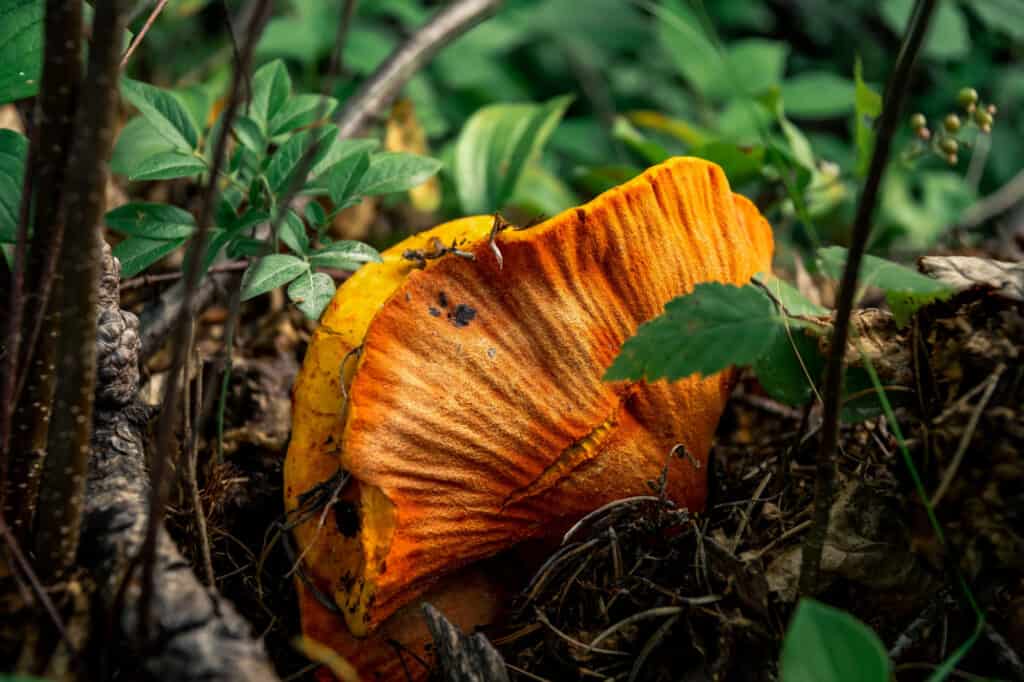
Most lobster mushrooms have a meaty texture.
©Raphael Rivest/Shutterstock.com
The mushrooms are almost never cultivated, but rather are available through foraging in the wild or maybe at farmer’s markets and specialty shops from other foragers. They love hemlock trees and grow near them.
The unique fungi was used for dyeing fabrics many years ago, creating shades from saffron to pale pink and everything in between. Northern California residents used them in the 1970s to create darker shades of red and purple in the dyeing, and they are still used the world over for these dyes.
Up Next:
- 10 Best Culinary Mushrooms
- 9 Wild Mushrooms Found in Fall
- 10 Wild Mushrooms Found in Spring
- Mushroom Hunting in Texas: A Complete Guide
The information presented on or through the Website is made available solely for general informational purposes. We do not warrant the accuracy, completeness, or usefulness of this information. Any reliance you place on such information is strictly at your own risk. We disclaim all liability and responsibility arising from any reliance placed on such materials by you or any other visitor to the Website, or by anyone who may be informed of any of its contents. None of the statements or claims on the Website should be taken as medical advice, health advice, or as confirmation that a plant, fungus, or other item is safe for consumption or will provide any health benefits. Anyone considering the health benefits of particular plant, fungus, or other item should first consult with a doctor or other medical professional. The statements made within this Website have not been evaluated by the Food and Drug Administration. These statements are not intended to diagnose, treat, cure or prevent any disease.
Thank you for reading! Have some feedback for us? Contact the AZ Animals editorial team.








